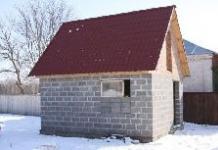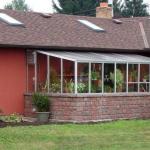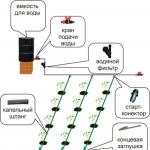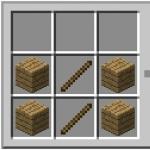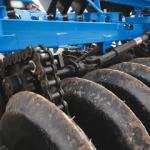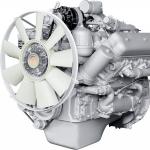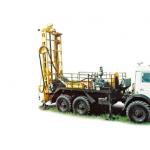The blades in the cutting tool are the basis of everything. A kitchen knife, grinder discs, chains for a lawn mower or a chainsaw with a well-sharpened blade simplify and speed up the work process.
You can sharpen a tool in a professional workshop or at home if you make a do-it-yourself knife sharpening machine from simple materials.
Not required for household knives special tool for sharpening, it is enough to have a sharpener in the form of a bar at hand. But if there is a chainsaw at home, the chains of which also need regular sharpening, or a grinder, the disks of which are constantly dulling, then it is better to make the installation yourself. The essence of the device is as follows: a bar is attached to the desktop in two variations - with or without adjustment. For those who do not understand the essence of making a sharpener with their own hands according to the text, they can watch photo or video master classes.
Device manufacturing scheme
In order for the device to turn out to be of high quality and safe, you need to calculate in advance the dimensions of the machine for sharpening knives with your own hands and select necessary materials. The first thing to do is to calculate the angle between the working part of the cutting blade and the bar.

This is followed by the selection of base materials (support) and stone. You can make a machine from glass covered with sandpaper or stone attached to a support. The first option is less expensive, and sandpaper can be changed at any time, but more reliable installation- made of stone.
Process Nuances
In order for the machine for sharpening knives according to the drawings with your own hands to turn out to be ideal and last for more than one year, you need to use the advice of specialists. The first thing to take into account is what kind of blade will be sharpened.

After all, an individual angle is selected for each knife:
- Blades for cutting hard objects (for example, cardboard, wood, metal), chainsaws - 30-45 degrees.
- Hunting, tourist knives - at an angle of 25-30 degrees.
- Kitchen cutting tool for cutting various products, you need to sharpen at 20-25 degrees.
- Simple knives for cutting bread, vegetables and fruits require 15-20 degrees of sharpening. At the same angle, you need to sharpen ordinary household scissors, as well as razor knives.
Necessary materials
If you need to make a sharpening machine, you will need the following materials:
- several wooden bars;
- sandpaper;
- cutting tools;
- drill with several drills.

Simple machine. Step-by-step instruction
- Step 1. Take three rails and place them so that together they form the letter H. The width of the middle rail should be equal to the width of the saw bar. Repeat procedure.
- Step 2. Place the rails perpendicular to each other, connecting their bases - the main structure for holding the saw bar is ready.
- Step 3. This is one of milestones! It is necessary to correctly calculate the angle of attachment of the bar relative to the rails. Calculate it with measuring tools and mark the places where the timber is attached to the vertical and horizontal rails.

If you want to universal fixture, then you need to make several retractable bolts at once at a spacing distance so that you can change the slope of the beam if necessary. This can be done with simple measuring tools and drills. After that, you can cut the slats to a convenient length.

The inconvenience of such a machine is that you have to independently control the location of the knife relative to the beam. If you do not want to think about anything at all while sharpening knives, scissors or chains, then you should make a more complex machine.
Universal machine. Step-by-step instruction

Read each step carefully and, where possible, draw a drawing for each step with all dimensions - this will be a great help in your work:
- Cut two pieces of plywood rectangular trapezoid, the bases of which will be equal to 60 and 170 mm, and the sidewall along right angle- 230 mm.
- Cut out a rectangular plank with dimensions of 230 by 150 mm.
- Fasten the rectangle between the bases so that it protrudes 40 mm upwards.
- Cut out a 60mm by 60mm block and attach it to the base of the wedge.
- Using a drill, make in a bar vertical hole at a distance of 50 mm from the center. Insert the futors from above and below the hole, and into them - a hairpin of the appropriate diameter, 25 cm long.
- Process rectangular base. At the level of 40 mm of the protrusion, make a cut of about 2 mm so that a sheet of sandpaper can be attached to this place
- Make a fixer:
- Take an L-shaped plank with dimensions of 15 by 18 cm along the long edges and an approximate width of each shelf up to 5 cm.
- Take a rectangular bar 5 by 5 cm.
- Make a groove in the plank at the level of the hairpin and fix the planks on it with minimal mobility.
8. Make a traffic controller:
- Secure the stud with a nut so that it does not rotate.
- From solid wood cut out a block with dimensions of 20x40x80 mm and fasten it to the stud with nuts.
- On the wide side, make a hole of 9 mm indented from the edge of 15 mm.
- Cut out two bars of 50x80x20 mm from hardwood and make one hole in them at a distance of 20 mm from the edge in the center.
- Take the welding of a stud and a smooth rod and fasten the bars on it as follows: first the fixing nut, then the first bar. Then aluminum profile, then the second bar and another latch.
- Glue the sandpaper to the aluminum profile.

The universal sharpening tool is ready. Cut out several templates with different angles so that you can refer to them as you work. Remember that at each stage of creating a tool, pre-created drawings will help you - do not neglect this step, otherwise it will be very difficult to avoid mistakes.
It doesn't matter what you need to sharpen - a simple kitchen knife, garden or nail scissors or chainsaw chains - such a tool will cope with any job if you set the angle correctly and remember to use it when the need arises.
Every housewife at least once in her life faced with the fact that her knives were blunt in the kitchen, with which she usually cuts bread, butchers meat or cuts vegetables. Using such knives is not only inconvenient, but also dangerous, because the blade can break off the product and injure you. Therefore, it is necessary to periodically undermine the tool with the help of special devices. In stores, such devices are presented in a huge assortment, but for certain reasons they do not suit consumers. In such a situation, a do-it-yourself knife sharpener can be made. Drawings and diagrams for work are, in principle, easy to find, but detailed master classes we present in this article.
What conditions must be observed when sharpening knives?
Do you know how to sharpen knives properly? In fact, there are a number of rules, following which you can achieve the perfect result.
The necessary conditions look like this:
- For long and efficient operation of knives when sharpening, it is necessary to pay maximum attention to the angle between the edges of the blade. During sharpening, it is imperative to restore the initially set angle so that it meets technological standards and allows you to cut products quickly, efficiently, freely.
- It is necessary to choose the optimal angle for each blade. So, for example, a scalpel or razor should have an angle of 10-15 degrees, devices for cutting fruits, bread and vegetables - 15-20 degrees. Knives for working with hard materials need to be sharpened at an angle of 30-40 degrees.
- It is quite difficult to sharpen the blade without a special device. Holding the knife with your hands only, ensure desired angle tilt is difficult. So just to make it easier this process There are sharpeners.
In fact, a do-it-yourself knife is made as easy as shelling pears, because all such devices have simple design And it won't take you long to create them.
Varieties and manufacture of stones for sharpening
Available for sale a large number of stones intended for turning knives, but the most popular of them are the following types:
- Water tools. Working with them necessarily involves the use of water, thereby saving the surface of the stones.
- Oil stone. It is very similar in shape and structure to water, the only difference is that its surface is a little oily.
- Natural stones. They are produced from natural materials, previously undergoing industrial processing.
- artificial tools. They are made from non-natural ingredients.
- rubber devices. They are no less common on sale, but working with them is extremely inconvenient.
Before you make a knife sharpener in the form of an abrasive bar, you need to purchase several glass plates 4-5 mm thick rectangular shape.
Then make the sharpener according to the scheme:
- With help double sided tape stick sandpaper of different grits on the surface of the plates.
- Tighten the nuts carefully so that the glass does not crack.
Important! During the operation of such a device, water is not used, which is why the abrasive wears out quickly enough.
When sharpening knives with an abrasive stone, avoid excessive sudden movements otherwise, it will overheat and the blade will lose its useful properties.
Products for sharpening knives made of wooden blocks
Making a sharpener from two abrasive and two wooden blocks is quite simple, the main thing is to source materials were the same size.
You will need to do the following:
- Carefully sand the wooden blocks with sandpaper, remove all burrs.
- Pre-mark the bars, taking into account the required angle of inclination.
- Attach a stone to the resulting line, mark its width on both sides of the wooden block.
- Make cuts according to the markings on the wooden workpiece.
Important! Make sure that their depth does not exceed 1.5 cm.
- Insert the abrasive stones into the recesses obtained so that they coincide with the grooves.
- Fasten the grindstones with bolts, attach a piece of rubber from below.
Do-it-yourself knife from mounting corners
Use this master class to get a high-quality do-it-yourself knife sharpener. Drawings can be taken on the Internet.
Tools and materials needed for work:
- Metal plates 4 by 11 cm.
- Aluminum corners standard size.
- Metal rods 15 cm long.
- Grinding machine with vise.
- Needle file.
- A set of bolts and nuts.
- File.

Make a sharpener according to these instructions:
- Make markings according to the drawing for the holes in the plates.
- Drill holes, cut threads.
- Round sharp edges and corners with a file.
- Make holes in the corner according to the diagram.
- Expand the needle support with a needle file.
- Cut the threads in the holes for the studs.
- Insert the rods into the extreme holes, fix them with nuts.
- Screw the bolt into the widest hole with the nut pre-threaded onto it.
- Insert bolts for clamping the knife into the remaining holes.
- Screw the nuts onto the ends of the rods, lay the corner on top to fix the nuts.
- Assemble a device to hold the sharpening stone from a thin metal rod, a wing nut and two holders.
Important! Such a sharpener can have the widest range of pressure angle degrees, it is incredibly convenient in terms of operation.
Making an electric knife sharpener at home
Do-it-yourself electric knife sharpener is made a little more complicated, because the device itself has a complex design.
Prepare the following materials and devices:
- Vacuum cleaner.
- Plan washer.
- Electrical engine.
- Stanin.
- Fencing.
Do the work, strictly following the scheme.
In households, it is often necessary to use cutting, sawing and planing tools. In the process of work, they lose their sharpness, and the blade needs to be restored to its original properties.
Taking the tools to the workshops to be sharpened is a reasonable option, but in order not to waste money again, you can make a device for sharpening knives with your own hands.
General information about knife sharpening
The goal of any kind of knife sharpening is to keep the blade sharp. And most important factor, which affects long-term and efficient operation - this is the value of the sharpening angle. The practicality of such a parameter is well evaluated in the course of work. If you look objectively, you can see that with a smaller value of the angle, the knife blade as a result is sharper. But with such an action, it turns out that the period of improved cutting qualities is not very long, that is, it becomes dull faster. The sharper a knife blade becomes during the sharpening process, the faster it will become blunt. On the basis of this regularity, it can be concluded that the angle must be chosen correctly and the false value should be observed uniformly along the entire length of the edge.
It should be noted that only those types of blades that have a certain degree of hardening are subject to sharpening. If the hardness of the steel on the cutting parts exceeds 55 HRC, then it cannot be sharpened with any improvised tool.
The golden rule for sharpening knives is to keep the sharpening angle of the cutting edge unchanged throughout its entire length.
To achieve this, professionalism, skills and special equipment are required, which will allow you to hold the tool in your hands, maintaining a given angle of inclination of each cutting edge.
In this case, you can take care of buying a special device, but such products are usually expensive, so you can try to make it yourself. For more information on how to make such a device at home, read below.
Video "Homemade design of a simple knife sharpener"
Features of using the device
Of course simple grindstone Suitable for sharpening a knife or cutting edge of a planer. But its quality will not be the best. To ensure uniform removal of the metal layer and the accuracy of processing, it is necessary to use special grinding devices.

The advantage of such a product is not only the convenience of its use, but also factors such as:
- The possibility of fixing the blades, which is quite reliable and does not exert excessive load. a properly designed device does not allow damage to the metal during operation.
- The ability to install the bar at a certain angle. Due to this, when the cutting edge moves, the angle value will not change.
- Variation of installation of different angles of sharpening. With this functionality, it is possible to process various tools, even sharpening knives with a stepped structure.
Materials and tools required for the device
To perform a simple and quite solid fixture, you need to take care of preparing the following blanks and tools:
- plywood or a small laminated chipboard sheet;
- steel stud with a diameter of 8 mm (the thread on it must be cut along the entire length);
- textolite or ebonite bar (alternatively, you can replace hard rocks wood - beech, oak, etc.);
- aluminum plate (with a thickness of at least 5 mm);
- fasteners - bolts, nuts (wing nuts);
- neodymium magnet (it can be found on an old computer HDD).
Do-it-yourself drawings of a tool for sharpening knives
After preparing and completing the materials, you can begin the process of assembling the fixture. First of all, we take plywood to be used as a bed, which should rest on the mounting legs at a certain angle in the range from 15 to 20 degrees. After that, the hairpin prepared by us is twisted into the lower part, its length should be approximately 35-40 cm. To make the fitting thread stronger, you can use glue or sealant.

In the center of the installed plywood, we fasten the aluminum plate. Before fastening it, it is necessary to make a groove, which in size will correspond to the diameter of the fixing bolts. It is worth noting that we are using an aluminum blade as this will help avoid damage to the steel blade of the knife.
After that, we proceed to the manufacture of a lever that will allow you to fix the emery on the device. To assemble it, use the rest of the stud. Then we take two textolite (or wooden) bars and by cutting out we make holders for the lever. On one side, the stops must be fixed with a wing nut.

Near the handle, it is optimal to provide for the presence of a spring-loaded block, which will allow you to quickly change the emery stone.

As the main elements, you can use blanks from home-made bars - we glue sheets to the aluminum plate sandpaper, while their granularity should be different. Such a device can be easily fixed in the lever.

home design feature- this is the presence of a hinge with a double degree of freedom. Such a device can be easily assembled using the same textolite bars for this. One of them must be screwed onto the threads of the vertical stud, and used as a horizontal pivot and height adjuster for the linkage (this is necessary to set the sharpening angle).
The function of the second bar having horizontal hole under the lever, lies in the fact that it must be screwed to the first.
Thanks to this, it is possible to ensure free type of movement of the entire lever structure vertically.

Knives are clamped with a plate, or fixed on the surface of a neodymium magnet. When removing the first layer with coarse types of abrasive, the blade must be securely fixed.
If it is necessary to perform fine-tuning, then you can install the blade on a magnet and perform the sharpening operation with little effort. The horseshoe of the magnets should be recessed flush with the tabletop and seated with epoxy.

Manufacturing homemade device for sharpening knives can be considered complete. It is enough to set the desired angle, slowly sharpen the edge with a smooth movement along the entire length of the blade.

Video "Knife sharpener with your own hands"
Device for sharpening knives on an electric emery
An electric sharpener will allow not only to speed up the work, but also makes it possible to obtain high-quality concave edge profiles on the blades, the so-called fuller sharpening. It is impossible to achieve such forms using a linear bar; therefore, these types of devices are not interchangeable, but complementary devices.

It is noteworthy that a person, working on a manual grinding device, controls the speed and intensity of the processes performed, while the emery wheel has a constantly high rotation speed, which can adversely affect the condition of the knife.
When friction metal surface lends itself to strong heating, which results in the "vacation" of the hardening of steel. The material loses many properties, it becomes less hard, which leads to grinding and the appearance of torn edges. Another problem with a "released" knife is the rapid loss of sharpness. In this regard, you need to work carefully on the electric emery, bringing the blade to sharpen the abrasive for short periods of time and taking frequent breaks so that the knife cools down.
Working in such modes, it is quite problematic to maintain constant angles, so the tool needs to be securely fixed during such processing.
To implement the design of such a device is quite simple. In the direction of the rotating axis on the emery there are guides along which the carriages with knives move. corners are held mechanically, and the forces are determined directly by the operator.

This type of fixture is quite simple to do with your own hands - while there is no need to perform precise work to process metal parts. For the manufacture of guides, the foot material is actually used.
On the workbench, near the sharpener, guides are fastened, with the help of which it is possible to change the distance from the knife stops to the abrasive. This distance affects the sharpening angle. On the vertical bar must be present up and down freewheel regulators, which have strong types of fixing the current positions.

The knife blade must be drawn horizontally, pressed against the thrust element. The force in contact with the emery must be adjusted directly in the process. Processing must be performed symmetrically, it is enough just to change the sides of the knife and sharpen them at the same angles.

The application of this method can only be suitable for processing classical type knives. Kitchen, hunting, tourist and other types of cutting planes various tools need a slightly different approach.
A common type of design for sharpening knives - "joiner"
For such a device, it is necessary to use a specialized emery, with an end type working surface. The guide under the carriage is placed at the bottom so that it is located away from the rotating axis. This is due to the fact that in this part of the abrasive wheel, its work is considered the most effective. Guides with cutting elements move manually, the clamps are provided by the own weight of the tool.

A drawing of each structural is presented in the image.
 This type of machine was used at the beginning of the last century, and for all the time the technology of its operation has remained unchanged. Due to the simplicity of this device, it is easy to make it for your home workshop. For this, any components made of metal, plastic, wood are suitable.
This type of machine was used at the beginning of the last century, and for all the time the technology of its operation has remained unchanged. Due to the simplicity of this device, it is easy to make it for your home workshop. For this, any components made of metal, plastic, wood are suitable.
By replacing the cutting element on the jointer, you can sharpen ice ax knives, the main thing is to maintain the correct angle, which should be more gentle. The same principle applies to sharpening scissors.
To sharpen a chisel and a knife from a planer, you can also use electric emery and locking carriages. But these types of tools are compact, and they can be sharpened with a mechanical device.
There are equivalent ways - along the edges, and across. In terms of quality, the processing is virtually identical; therefore, it is impossible, therefore, to single out a specific type of fixture.
For factory products, transverse edits of the blades are assumed.
By a similar principle, thick plywood is taken from which the card case is made. Any rollers can be used as a guide, preferably in an amount of more than two. By moving the machine along the surface of the emery, the ideal shape is given to the blade of the chisel.
If serious types of sharpening are not required, simpler devices are also suitable for small edits.
Fasten the bars with the required angles of inclination to the chisel. Put emery and a piece of glass near them. On glass surface you need to apply a solution of soap.
You will be pleasantly surprised by the effectiveness of such devices.
For transverse sharpening - it is worth making a simpler device, where the guide element is also used as a support. A blade is fixed vertically on the movable part. The only drawback of this is the fixed angle, which is set during the manufacturing process.

But, compared with a knife, the deviations from ideals that have arisen are not so critical.
This type of fixture can be used to sharpen planer knives. But due to the wide size of the blades, the process is somewhat more complicated. In this regard, you can use an electric grinder that has an end working surface.
The stops are made from wooden blocks. It is important to provide for the possibility of changing angles. Clamps are provided by the operator, and semi-circular sharpening can be performed, which is very indispensable for carpenters.
Naturally, this device is convenient to use for sharpening the edges of chisels. If given high rate performance - you can restore tools even with a large number chipping.
Now you know how you can create a homemade sharpener to perform all the necessary operations for sharpening knives at home.
Video "Device for sharpening various types of knives"
With the help of a knife, we cook food, cut food and perform other household chores. Therefore, it is very important that the blade of the knife always remains sharp. Theoretically, there is nothing complicated in sharpening knives, but in practice it turns out that not everyone can sharpen a blade well. To have an idea of how to sharpen knives and how to do it correctly, we advise you to read our article.
Before you start sharpening a knife, you need to find out what material it is made of. There are several types of knives:

- Carbon steel knives are the most affordable, made from an alloy of iron and carbon, easy to sharpen and stay sharp for a long time. Among the shortcomings, it can be noted - oxidation of the knife blade from interaction with food or an acidic environment, because of this, rust and stains appear on the knife, and the products acquire a metallic taste. Over time, after the formation of plaque on the blade, oxidation stops.

- Low carbon stainless steel knives are made from an alloy of iron, chromium, carbon and in some cases nickel or molybdenum. Stainless steel knives are inferior in hardness to carbon steel, so they dull quickly and require regular sharpening. The advantages include - resistance to corrosion.

- High carbon stainless steel blades - more high class knives, with a high carbon content and additives of cobalt or vanadium. Due to the higher quality alloy, this species knives do not require frequent sharpening and are not subject to corrosion.

- Damascus steel knives - mainly made as edged weapons, but there are also kitchen options. Damascus steel knife is a multi-layered blade made of different alloys High Quality. The disadvantages include the high cost of knives.

- Ceramic knives have gained popularity because of their sharpness and ability not to dull for a long time. But in addition to the advantages, ceramic knives have a significant disadvantage, which is their fragility when falling from a height and poor fracture resistance.
Sharpening tools
Touchstone (whetstone)

Sharpening stones are available with different amount abrasive grains square millimeter. Therefore, for rough sharpening and finishing grinding, it is necessary to use bars with a minimum and maximum abrasive content. In foreign-made whetstones, information about the number of abrasive grains is on their marking. whetstones domestic production you have to choose “by eye” or ask the seller which whetstone to use for primary and which for finishing sharpening.
Mechanical sharpener

Mechanical sharpeners are mainly used for sharpening kitchen knives. The sharpening process, although it happens quickly, but the quality leaves much to be desired. For this reason, for hunting and sporting knives, it is recommended to use other sharpening methods.
electric sharpener

Modern models electric sharpeners, allow you to achieve high quality sharpening, due to the built-in function, automatic detection of the angle of the blade. The electric sharpener is great for both domestic use, and for sharpening knives in catering organizations. The lineup electric sharpeners presented in a wide range, so the price may be different, but if you want your knives to always remain sharp, then buy more "advanced" and expensive models.
Musat

Musat - designed to maintain the sharpness of the edge of the knife. In shape, musat resembles a round file with a handle. Musats are included in knife sets, and many owners often confuse them with a tool for full-fledged sharpening of the blade. Please note that with the help of musat you will be able to maintain the sharpness of a sharpened knife, but if the knife is completely dull, it will not work to sharpen it with musat.
Sharpener "Lansky"

This sharpener is used for sharpening small and medium-sized knives. The design of the sharpener allows you to sharpen the blade at your chosen angle. Sharpener "Lansky" consists of a rod with a removable whetstone and two corners connected to each other. The corners simultaneously serve as a vise for the knife and a scale for selecting the sharpening angle. The sharpener also comes with ANSI marked whetstones in various grit sizes.
Sharpening and grinding machines

Sharpening machines are mainly used in production, for high-precision sharpening of blades of rotating shafts. In addition to high-precision machines, there are electrically driven abrasive wheels and rotating grinding discs. Sharpening knives on such machines should only be done by an experienced craftsman, because due to the speed of rotation of the circle or disk and high temperature heating, with any unsuccessful movement, the knife blade will become unusable.
Self-sharpening blades
Sharpening a knife with a whetstone
The sharpening of the blade, made by a whetstone, is considered the highest quality, of course, provided that it was produced experienced master. To sharpen a knife whetstone do the following:
- Place a whetstone with a low content of abrasive grains on a fixed surface. If the bar is small, it can be clamped in a vise.

- Holding the knife at an angle of 20-25 degrees in relation to the surface of the bar, start moving the knife along the touchstone cutting edge forward.

- Move the blade along the bar in such a way that during the movement it touches the surface of the whetstone, along its entire length.
- Try to keep the same blade angle while moving.
- After 2-3 strokes, turn the knife over and repeat the sharpening process on the other side of the blade.
- Thus, alternating sides, sharpen the knife until an edge (burr) appears along the edge of the blade.
- Change the rough sharpening stone for a grinding stone.
- Sand the knife blade until the edge is gone.
- Test the sharpness of a knife by cutting through a hemp rope that has been folded several times, or try cutting through a piece of paper.
How to sharpen a knife with a whetstone, see also the video:
Sharpening a hunting knife on a Lansky sharpener
Hunting knives are made of hard steel, so their initial sharpening requires whetstones with a low content of abrasive grains.

- Clamp the knife in the vise of the sharpener.
- Install a whetstone with a low content of abrasive grains on the shaft.
- Select the angle of the bar (for hunting knives it is usually between 20 and 30 degrees).
- Insert the rod into the desired hole.
- Lubricate the whetstone with the special oil included in the sharpener set.
- Start moving the bar along the blade of the knife, from the base to the tip.
- Turn the sharpener over and repeat the process on the other side of the knife.
- After the edge is formed, change the stone and do the final sanding.
- Since hunting knives are mainly made with a double-edged blade, after completing sharpening on one side, change the position of the knife in the vise and start the sharpening process on the other side.
- When finished sharpening, polish the knife blade with felt.
How to sharpen knives in a Lansky sharpener, see the video:
Sharpening scissors
Sharpening scissors must be done on a special grinder. Sharpening blades with the help of improvised (sandpaper, the edge of a glass, etc.) can temporarily improve the sharpness of scissors, but not for long. If you do not have the opportunity to sharpen scissors from a professional, then you can try to do self-sharpening about abrasive stone. When sharpening, you need to follow a few simple rules:

- The sharpening stone should be fine-grained.
- The blade is sharpened over the entire surface of the edge at the same time.
- The angle of the blade must match the factory edge.
- The movement of the blade over the stone must be done from the screw to the tip.
- You need to sharpen scissors in disassembled form.
When sharpening scissors, do not rush, patience in this matter will be your ally.
How to quickly sharpen scissors, you can also see in the video:
Sharpening plane and chisel blades
Sharpening the blade of a planer and a chisel practically does not differ from each other. Therefore, the sharpening process described below applies to both tools:

- Set the chisel on the whetstone at an angle of 30-40 degrees.
- Holding the chisel with your hand, fingers free hand press the chamfer to the donkey.
- Start running the chisel over the grindstone until a burr forms on the smooth side of the chisel.
- Change the touchstone to a fine-grained one and make the final grinding of the chisel.
- Check the sharpness of the chisel blade by removing chips from the corner of the bar.
Apart from manual sharpening, the chisel can be sharpened on a machine with a rotating abrasive disc:

- Turn on the machine and let the disc reach full speed.
- Holding the chisel with both hands, lean its bevel against the grinding wheel.
- Be sure to observe the angle of the chisel, otherwise you will ruin the blade of the tool.
- Do not press the chisel with too much force and do not hold it too long on the disk, this will lead to overheating of the metal and destruction of the blade.
- While sharpening, wet the blade with water.
- The final grinding of the chisel blade is best done by hand, using a fine-grained bar or sandpaper.
Do not forget that when sharpening products on the machine, a lot of sparks and small particles are formed that can get into your eyes, so be sure to work with safety glasses. And in order not to injure your hands on a spinning disk, wear gloves.
You can also learn how to sharpen tools from the video:
Tips for quickly sharpening the blade with improvised means
Stone
To quickly sharpen a knife on a hike or on a picnic, you can use an ordinary cobblestone. Use any stone lying on the ground instead of a whetstone and run the blade of a knife along its surface. You will not achieve razor sharpness, but you will return the knife to working condition.
Second knife
It is quite possible to sharpen two knives at once, without sharpening stones and accessories. To do this, you need to take a knife in both hands and start sharpening the blade of one knife on the blade of another. After 5-10 minutes of this work, the knives will become sharper than before.
glass items
The blade of a knife can be sharpened slightly on the rough edge of glass or ceramic objects. For example, about the bottom of a glass or edge tiles. The main thing is that the surface is rough.
Leather belt
A leather belt is more suitable for finishing and razor sharpening a knife blade than for rough sharpening. But if there is nothing at hand except for the belt, then you can try to sharpen the knife on it. To do this, you need to give the belt a stretch and start to drive along it with a blade, you may not achieve strong sharpness, but you will polish the knife to a shine. 
By learning how to sharpen knives and tools yourself, you will acquire a skill that will be useful to you throughout your life!
With repeated use of knives, every housewife is faced with a problem when they begin to become dull and it becomes simply impossible to work with them. In addition, it is unsafe, as the knife may slip off while cutting and injure you. To prevent this from happening, the knives should be sharpened in a timely manner using a special sharpening device.
You can buy a knife sharpener at your local hardware store or market, where they offer you different kinds devices. You will have to choose on your own. But, in order not to be mistaken, you need to know how to properly evaluate them in terms of convenience and quality of operation.

The options offered do not always suit consumers, so many make sharpeners with their own hands, using special stones, tools and drawing sketches with dimensions. The photo shows options for homemade knife sharpeners.

Features of knife sharpening
When sharpening knives, the main thing to do correct angle the edges of the blades so that they serve you long and efficiently. Therefore, when sharpening knives yourself, it is necessary to maintain the existing angle of inclination of the blades.

Each knife blade has its own optimal angles slope:
- from 10 to 15 degrees - for a medical scalpel or straight razor;
- from 15 to 20 degrees - for household knives used for cutting bread, vegetables or fruits;
- from 20 to 25 degrees - for multifunctional knives for cutting a variety of products;
- from 25 to 30 degrees - for reliable companions of hunters and tourists on long trips;
- from 30 to 40 degrees - for cutting materials that are particularly hard.









To sharpen the correct angle of the blade, you will need special tools, since it is difficult to do this manually.

The design of such devices is not complicated, so it is easy and quick to make it yourself, and detailed instructions for the manufacture of sharpeners can be borrowed from the Internet.

Types of knife sharpeners
From a large assortment various kinds choose knife sharpener desired option easy enough for yourself.

The main elements of the sharpening device are the stop for fixing the knife and abrasive block, which is used as ready-made abrasive materials (stones) or own production. But before you get to work, you need to learn how to make a knife sharpener with your own hands.

Types of stones for sharpening
There are several types of grindstones:
- water. Sharpening stones used in water wear out less during operation.
- oil. In structure and configuration, they are similar to water ones, but with a more oily surface.
- natural. For their manufacture, only natural raw materials are used with pre-treatment during the production process.
- artificial. In this case, the name speaks for itself, that is, the abrasive material is created artificially.
- rubber. They are not as common as the previous ones, besides, they are inconvenient in the process of application.

What can you make a sharpener for sharpening
To make a whetstone with your own hands, you can use the most in a simple way. Take a small rectangular glass plate about 5 mm thick. Using double sided tape fix on it on both sides strips of sandpaper of coarse and medium grit.

The bar is ready for use, if necessary, worn sandpaper can be easily replaced with a new one. This method is the most budgetary in terms of cost.









The disadvantages of this device include:
- rapid wear of the abrasive and fragility of the product (when fixing the beam, you need to be careful that the glass does not crack).
- possible overheating of the material during rapid movements during the sharpening process.

You can find the best knife sharpener ideas on the relevant websites.

Wooden bars
This method of making a tool for sharpening knives is also simple and accessible to everyone. You will need four identical bars: two abrasive and two wooden.

At the beginning of work, sand the wood blocks with sandpaper so that their surface becomes smooth without burrs. Make a marking of the bar in accordance with the required angle of inclination. Attach a whetstone and mark its width on a block of wood.

Note! 
Make 1.5 cm deep cuts on the basting and insert the abrasives into the grooves. Secure the stones with bolts. A piece of rubber fixed at the bottom will give the structure stability.

In addition, you can make an adjustable sharpener with your own hands, but the next article will tell you how to do this.

DIY knife sharpener photo






Note! 










Note! 

















